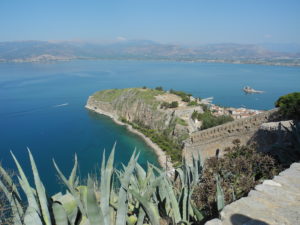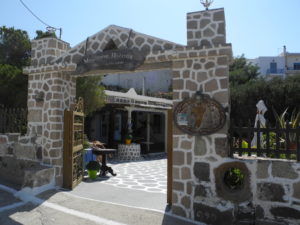Europe
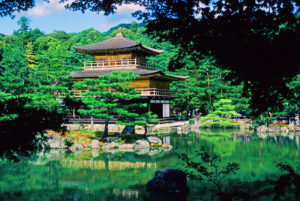
Kyoto’s Kinkaku-ji Zen Buddhist Temple of the Golden Pavilion. Photo by Dennis Cox/WorldViews
Barcelona, Spain. Udaipur, India. Siem Reap, Cambodia.
Rome and Florence, Italy. Santa Fe, New Mexico and Charleston, South Carolina, U.S..
Luang Prabang, Laos. Ubud, Indonesia (Bali).
Cape Town, South Africa. Hoi An, Vietnam.
Kyoto, Japan. Chiang Mai, Thailand.
Oaxaca and San Miguel de Allende, Mexico.
What do these cities have in common? If you said “very little,” you’;d be right, but you’d also be wrong.
They were all voted into the top 15 of the “World’s Top Cities” by the readers of Travel + Leisure Magazine. The criteria included sights/landmarks, culture, cuisine, friendliness, shopping, and overall value.
Where are the Usual Suspects?
Notable absences include London, Paris,. Venice, Prague, St. Petersburg, Istanbul, Jerusalem, Rio de Janeiro, Buenos Aires, New York, Chicago, San Francisco, Vancouver, Hong Kong…not even such trendy destinations as… Continue reading
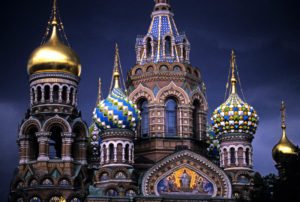
St. Petersburg, Russia: can be visited without a visa. Photo by Dennis Cox/WorldViews
Note: This is the sixth in a series of Baby Boomer Travel Guides and the fourth in the series focusing on transportation options around the world. Please go here, here, and here for the previous posts.
Scandinavia and the Baltic States compose far Northern Europe (we’ll cover Germany, The Netherlands, and some other northern European countries in a subsequent post), and feature some of the best scenery, most sparsely populated spaces, and lively yet historic cities in Europe.
Ships and trains offer the most convenient and comprehensive forms of transportation here, but driving among some of the countries is certainly doable.
And Denmark, especially, is well-suited to biking, with plenty of bike paths and flat terrain.
Getting Around The Baltics
The Baltic region is excellent for cruising because the main ports — Oslo,… Continue reading

Hagia Sophia (Church of the Holy Wisdom) at dawn in Istanbul, Turkey. Photo by Dennis Cox/WorldViews
Note: this is the fifth in a series of Baby Boomer Travel Guides. In our last post, we looked at the options for seeing the Caribbean. Today we focus on means of transport around the Mediterranean Sea.
When traveling around the Mediterranean region, you have a full range of options: taking a cruise ship or ferry boat, driving, taking trains, or flying between destinations.
(If you’re on a guided tour, you’ll most likely be traveling by bus, though other forms of transport may figure in as well.)
How you choose to get around this endlessly fascinating area is one of the biggest decisions you’ll make — maybe the biggest decision — regarding your Mediterranean trip. It will color your entire experience — for the better, we hope.
Each mode of transport has its… Continue reading
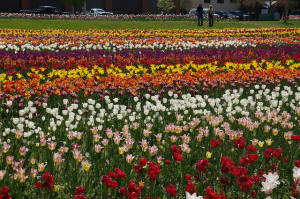
Dutch tulips: better than cave biking. Photo by Rachel Kramer on flickr.
According to a recent survey of 40 countries around the globe conducted by motor home rental site SHAREaCAMPER, the Netherlands has the most adventurous people per capita, followed by Australia and Sweden.
The survey tabulated the number of online searches in each country for such adventurous activities as skydiving, bungee jumping, hiking, rock climbing, skiing, surfing, BMXing, and caravanning — the latter being what Australians (where SHAREaCAMPER is partially based) call traveling in RVs, campers, or motor homes.
Strictly in terms of sheer numbers of total searches, the United States placed first, but of course has a much higher population than the other countries. The U.S. finished ninth in the per capita rankings.
While the Netherlands was outdone in skiing by Norway and Australia in surfing (no surprises there), Switzerland in… Continue reading
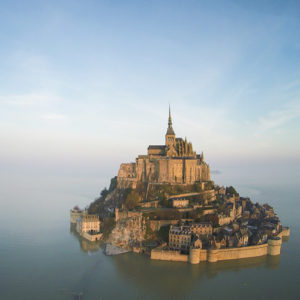
Mont-Saint-Michel is a remarkable sight as you approach. Photo from Normandy Tourist Board.
As regular readers of this blog know, I have a soft spot for off-the-beaten-track destinations.
Yes, I love Paris and Venice and London, but I also like to explore the lesser-known out-of-the-wsy places that many travelers never reach.
Once years ago, I set off by train from Paris to visit Mont-Saint-Michel, a medieval abbey off the coast of Normandy that I had read about in college in the Henry Adams’ book, Mont-Saint-Michel and Chartres.
The trip took two full days because the train connections were awful, but I made it, and didn’t regret it. It’s a dramatically situated Gothic masterpiece, rising atop a rocky island with a maze of narrow streets surrounding it.
Traditionally, Mont-Saint-Michel has only been reachable by land when the tides are out, via squishy mud flats. When the tides come in,… Continue reading
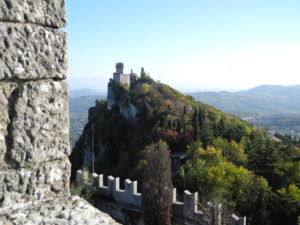
A dramatically perched fortress tops Mount Titano. Photo by Catharine Norton.
In a recent post, I noted that the tiny Republic of San Marino, which is entirely surrounded by Italy, was number one on my personal bucket list.
The main reason was that it was the only country in Western Europe that I hadn’t visited, and that since I would be visiting Italy soon, I could then cross it off my list. Of course, I also wanted to go for all the reasons I want to go anywhere — seeing what there is to see and, I hope, enjoying it — but I admit the list thing was the top consideration.
As it happens, I did visit Italy shortly after the post appeared, and I did make it to San Marino — whose irresistible full name is The Most Serene Republic of San Marino.
And — as a… Continue reading
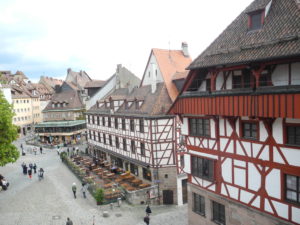
Nuremberg’s medieval city has been carefully reconstructed following Allied bombing in WWII. Photo by Clark Norton
I might never have visited Nuremberg, Germany, if it hadn’t been the starting point for a Danube River cruise last fall.
My wife, Catharine, and I arrived in Nuremberg several days early, intending to use it as a base for exploring the surrounding area, a region of Bavaria known for its charming medieval towns, rolling hills, and Autumn beer festivals.
But we ended up being so enamored of Nuremberg that we never left the city during our four-day stay there.
We were entranced by pathways leading intriguingly along ancient city walls, covered footbridges that crossed bucolic rivers and canals, flower-filled parks that attracted residents out for Sunday strolls, winding streets that unveiled tempting little restaurants and taverns, and half-timbered houses lining picturesque squares.
One square is anchored by the former home… Continue reading
Although I’d been to Greece twice before, I wasn’t familiar with the town of Nafplio (also spelled Nafplion) until four members of my family and I spent several days there recently to attend a baptismal ceremony and celebration for the baby daughter of some friends. (More on that in my next post.)
Nafplio is about a two-hour drive from the airport in Athens, and is located at the northern end of the Peloponnesian Peninsula, where the Peloponnesian War pitted the Athenians versus the Spartans in the 5th century BC.
The militaristic Spartans prevailed over the once-dominant but philosophically minded Athenians, dealing a fatal blow to the golden age of ancient Greek democracy.
It was kind of like the Michigan State Spartans football team taking on the UC-Santa Cruz Banana Slugs. Ouch.
Nafplio,… Continue reading
Fourth in a Series:
During my week on the Greek island of Milos, I saw no Mexican restaurants, no sushi bars, no French bistros, or even a Chinese take-out joint.
Yes, there were casual cafes that served pizza, burgers, or crepes as part of their offerings, but no dedicated ethnic eateries or American fast-food places.
All this was fine with me. My family and I ate Greek food three times a day — more if you count the occasional snack — and never got tired of it.
Not only was it almost invariably fresh and delicious, but the variety in selection and preparation far surpassed what you might expect to find in a Greek restaurant in the United States. Our diet went way beyond the familiar gyros,… Continue reading
Third in a Series:
During my recent week’s stay on Milos, one of the most beautiful of Greece’s Cyclades islands, I sampled several different beaches. And when I say different, I don’t mean merely separate — I mean distinctly different from each other.
Along with notable history, scenery, whitewashed villages, and food, Milos excels in its beaches.
Dozens of them are scattered around the island, some of them accessible only by boat, others by rough road, still others easy to reach by any vehicle, including bicycles. One long stretch of sand, along the inner harbor, is close to the island’s largest town, Adamas, and features calm waters, a beach bar, and even a touch of thermal warmth left over from Milos’ volcanic past.
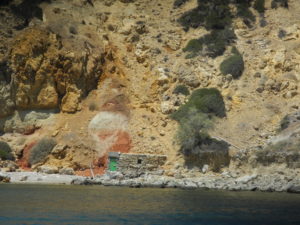
Colorful cliffs form a dramatic backdrop to Paliochori beach on Milos. Photo by Clark Norton… Continue reading

